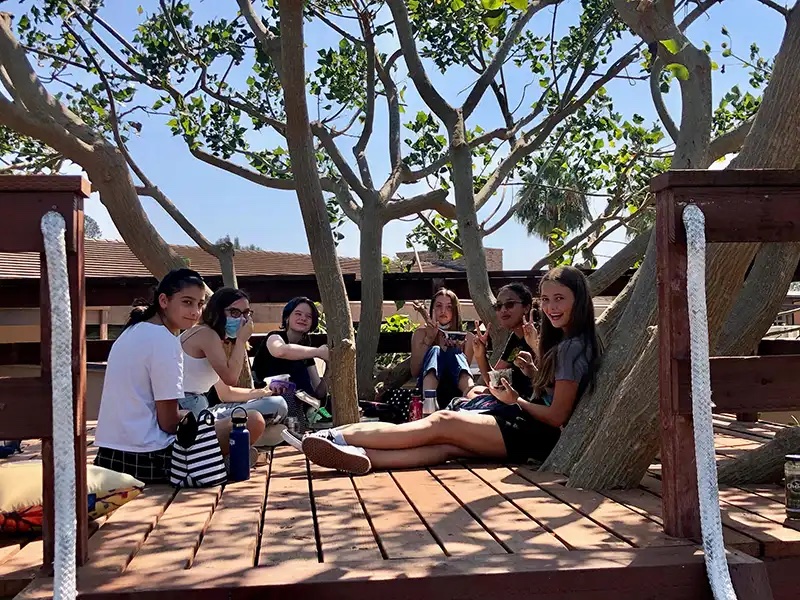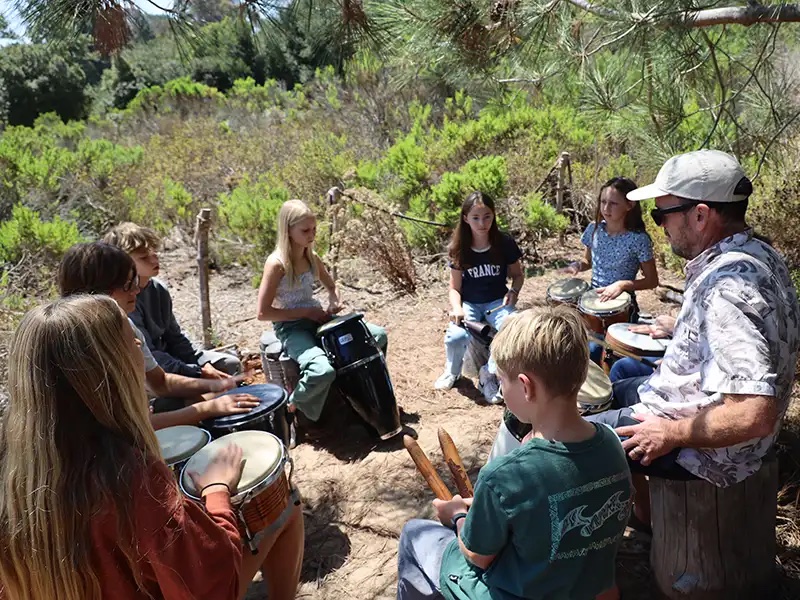Creating learning environments can be a wide-open world, a Grateful Dead improv. Or it can be militarily rigid, maybe for some cause. Some seem highly inefficient by our standards, and yet completely adapted to their native cultures, and those schools can be colorful and fantastic. Some seem to have deep or exotic roots. Some classrooms are not models of our top definitions of efficiency, unless your variable is how kids are seen, how lucky they feel to get to a real school or have a teacher who gets them, or how immersed they become in a “classroom”… whatever a classroom really is. Let’s never forget that the image that comes to mind when we think “school” or “classroom” might be envisioned with blinders on. Let’s explore…
What kind of classroom sparks imagination and that sense of wonder? It’s expeditions week at here at The Grauer School where learning takes to the road but, wherever you are, maybe it’s a great week to look outward and around our beautiful world of schools.
One of my favorite side projects has been visiting and studying cool schools from around the world. I’ve visited or served at hundreds. I have learned much from biophilic and vernacular classrooms, connected to nature and cultures, and I think you will be inspired by them. I’m betting there are way more educational options than you realize.
Some magic schools show how adapted they can be to local ecosystems and traditions. Others seem like little outposts where expatriates can gather daily in their home cultures. I once served (as a board member) at a little school in northeast Panama, receiving students who paddled to class every day through the mangroves in dugout canoes. A life precious and always at risk.
Here is a collection of cool classrooms I’ve loved reading about or visiting. Some of these classroom descriptions can be found in an article by a 15-year old homeschooler at this link: https://progressiveschooling.com/7-of-the-most-innovative-and-coolest-schools-in-the-world. I am fascinated by these unique concepts, and I hope you will find ones that call you. Which ones would you visit on your vacation, which convey a very hard life, and which are both? And if you teach, which of these could jolt you — and your students — out of the daily slog and sleepwalking we’re all prone to?
- Nomadic Siberian School (Russia) – Siberian kids travel to portable tipi-like classrooms as their families are reindeer herders. They hold lessons where the herd goes.
- Thinking Huts 3D‑printed School (Madagascar) – First-ever 3D‑printed classroom in Africa, visioning rapid sustainable school building in underserved regions
- Grauer School Vernacular Classrooms (Encinitas, CA, USA) – Grauer hosts examples of vernacular architecture in education — schools or classes that emerge from local materials, climate, and cultural building traditions. Tree‑Stump Circle: Students gather in a circle of native tree stumps in a sandy wash circle perched beneath the native Torrey pines—used for Socratic core‑value meetings and nature reflection, music, literature. Tree‑House Classroom: A hidden loft nestled among branches of a Hawaiian coral tree, perfect for immersive lessons in ecology and wonder, poetry, or just lunch.
- Sandy Hook Elementary (Newtown, CT, USA) – A biophilic, forest‑edge campus with large windows, natural materials, and a healing garden to support emotional well‑being. Sandy Hook has become a deeply moving place for permanent healing.
- Hogan-Based Learning: Navajo Preparatory School (Farmington, NM) – Students learn in modern classrooms, but the school grounds include traditional hogans (round, earth-and-wood dwellings). These are used for ceremonial gatherings, storytelling, and Navajo language and culture classes. The hogan provides not just shelter but a cosmological orientation — its door faces east to greet the sunrise, reminding students of their place in the cycles of life. In these settings, lessons on ecology, astronomy, and responsibility are taught holistically, blending science and spirituality.
- Green School (Bali, Indonesia) – This school consists of the famously towering open-air bamboo structures that form the classrooms, with thatched roofs that spiral like snail shells. No walls separate students from the rainforest. Instead, flowing air and bird calls are part of the learning environment. Desks are handcrafted from bamboo, and even the chalkboards are framed with woven reeds.
- Niki‑de‑Saint‑Phalle Elementary (Saint‑Denis, France) – The building’s hemispherical wings resemble brain lobes—brightly colored and organically shaped interior pods inspire creativity.
- Nationality Rooms (University of Pittsburgh, USA) – A standout amongst these creative “Nationality Rooms” is the African Heritage Classroom: a meticulously recreated Asante temple courtyard, complete with carved benches and cultural artifacts. This is an Asante-inspired space with dark wood carvings, woven mats, and clay-colored walls. Students sit on low stools arranged in a circle, surrounded by symbolic artwork and traditional ceremonial objects.
- Energy‑Positive Portable Classroom (Hawaii, USA) – A modular classroom that generates more power than it uses—solar saw-tooth roof and natural ventilation in island environments.
- Ørestad Gymnasium (Copenhagen, Denmark) – A massive glass cube with no traditional classrooms, encouraging collaboration across flexible open spaces.
- Escola da Ponte (Portugal) – The democratic schools movement has grown enormously. This one is an open‑plan elementary school run by students and teachers together. No fixed classrooms, no desks in rows—the school has no assigned classrooms. Instead, students and teachers move through airy, loft-like spaces filled with natural light, colorful rugs, and low bookcases. Groups form organically around shared projects, sitting on the floor or at round tables, creating a studio-like hum of activity.
- The Hive, NTU (Singapore) – Heatherwick-designed “dim sum” towers with 56 cornerless classrooms and a central atrium to foster incidental interaction and propinquity. Honeycomb-shaped towers with curving walls are said to encourage inclusivity and collaboration. Natural light pours through circular atriums, while inner gardens and wooden finishes blur the line between inside and outside.
- Gando Primary School by Diébédo Francis Kéré (Burkina Faso) – Earth‑brick classrooms with ventilating canopy roofs built by the local community, sustainable in extreme heat.
- Reggio Emilia Preschools (Italy) – The inspiration for Reggio Emilia schools all over the world, many in the US: These preschools use “atelier” classrooms designed as mini art studios. They have large windows to flood the space with light, mirrors to reflect the children’s work, and provocations—tables of clay, paint, or natural materials—to spark curiosity. Plants, hanging mobiles, and tiny furniture give the rooms a sense of enchantment and child-sized wonder. Studio-like rooms where light is treated as a co-teacher: huge windows, mirrors bouncing reflections, and lanterns create a sense of magic. Materials—clay, twigs, paints, fabrics—are beautifully arranged to invite exploration. Children move fluidly between areas, discovering the “hundred languages” of expression. Plus, children are the tour guides when you visit them in beautiful Piedmont, Italy.
- Zi Ling Changxing Kindergarten (Huzhou, China) – Classrooms are shaped like soft clouds, with round windows framing views of sky and water. Reflective white floors and curvilinear furniture are said to give an otherworldly calm, while pools and play spaces flow organically around learning pods.
- Mid‑Cave Primary School (Guizhou, China) – Carved into a cave, this space uses natural acoustics and earth walls as teaching aids. Vernacular education!
- Ding Dong Tree Classroom (Scotland) – Beneath a 150-year-old beech tree, kids gather on blankets amid roots, exploring nature and mindfulness.
- Boat Schools (Bangladesh) – Floating classrooms that navigate seasonal floods, bringing lessons directly to riverbank children.

Floating schools, forest schools, or desert tent schools are all over the world! There are too many to cover and the vernacular school might be something like a worldwide movement. As a school developer, I constantly see schools evaluated by how scalable, efficient, and easily replicable they are, and this concerns me. These classrooms and learning settings remind us of the preciousness of what cannot be scaled, the spaces uniquely formed by human connection.
Each of these classrooms breaks traditional boundaries—whether by blending architecture with ecology, democracy, technology, or community-built sustainability. But in a way, since they each are shaped based upon local ecosystems and traditions, maybe they don’t break traditional boundaries so much as revive and preserve them. Each of these schools is a way of avoiding bureaucracy, bigness, institutionalization, and standardization.
A great classroom attempts to immerse learners in atmospheres and cultures that spark curiosity, unique connection, and wonder.
Join the Small Schools Movement!
Would you like your organization or small learning community showcased in our member spotlight? If you are not yet a member of the Small Schools Coalition, we welcome you to become a friend free of charge.
If you are already a member, contact us to discuss how we can give you the complimentary platform to show the entire world what makes your small school special!


Recent Comments